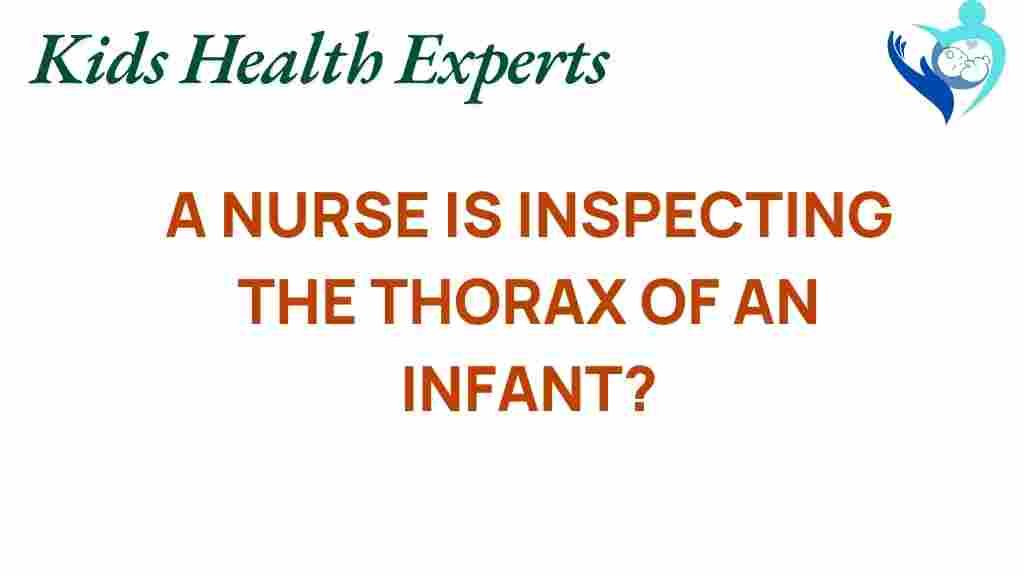Uncovering the Secrets: Why a Nurse Examines an Infant’s Thorax
Infant health is a priority for parents and healthcare professionals alike. One essential aspect of maintaining that health is the thorough examination of an infant’s thorax. Pediatric nursing involves a comprehensive approach to assessing and ensuring the well-being of infants, and thorax examination plays a critical role in this process. Understanding why and how nurses conduct these examinations can provide valuable insights into the significance of respiratory health and early diagnosis in infants. In this article, we will explore the importance of thorax examination, the steps involved in the process, and tips for parents on what to expect during these assessments.
The Importance of Thorax Examination in Infant Health
The thorax, or chest, houses vital organs such as the heart and lungs. For infants, whose respiratory systems are still developing, any abnormalities in this area can lead to serious health issues. Here are a few key reasons why thorax examination is crucial:
- Early Diagnosis: Identifying respiratory issues early can prevent complications and lead to better outcomes.
- Monitoring Development: Regular thorax examinations help track the growth and development of an infant’s respiratory system.
- Assessing Functional Capacity: Nurses can evaluate how well an infant’s lungs are functioning through careful examination, which is essential for overall infant care.
- Detecting Congenital Conditions: Some infants may be born with conditions affecting the thorax that require immediate attention.
How Pediatric Nurses Conduct a Thorax Examination
The thorax examination is a systematic process that trained healthcare professionals follow to assess an infant’s respiratory health. Here’s a step-by-step guide on how a nurse performs this examination:
Step 1: Preparing the Infant
Before the examination begins, nurses ensure that the infant is comfortable. This may involve:
- Ensuring the room is warm to prevent the infant from getting cold.
- Using soothing techniques, such as gentle talking or holding the infant.
- Positioning the infant appropriately, usually in a supine position (lying on their back) or semi-reclined.
Step 2: Visual Inspection
The nurse starts the thorax examination with a visual inspection of the infant’s chest. They look for:
- Symmetry of the chest wall.
- Any signs of respiratory distress (e.g., retractions, nasal flaring).
- Color changes in the skin, such as cyanosis.
Step 3: Palpation
Next, the nurse gently palpates the thorax to assess:
- Chest expansion: Evaluating if both sides of the chest expand equally during breathing.
- Vocal fremitus: Feeling for vibrations when the infant makes sounds.
Step 4: Auscultation
Auscultation is a critical part of the thorax examination. The nurse uses a stethoscope to listen to the sounds of the lungs. They look for:
- Normal breath sounds, which should be clear and equal on both sides.
- Abnormal sounds, such as wheezes, crackles, or decreased breath sounds, which may indicate respiratory issues.
Step 5: Documentation and Follow-Up
After completing the thorax examination, the nurse documents their findings and may communicate any concerns with the parents or guardians. They may also recommend further tests or follow-up appointments if necessary.
Troubleshooting Tips for Parents
For parents, understanding what to expect during a thorax examination can alleviate anxiety. Here are some tips to consider:
- Stay Calm: Infants can pick up on their parent’s emotions. Staying calm can help soothe your baby.
- Ask Questions: Don’t hesitate to ask the nurse any questions regarding the procedure or findings.
- Provide Comfort: Bring a favorite blanket or toy to help comfort your infant during the examination.
It’s also beneficial to keep track of your infant’s health history and any symptoms you’ve noticed. This information can help healthcare professionals make informed decisions regarding your infant’s care.
Conclusion
In conclusion, the thorax examination is a vital component of pediatric nursing that plays a significant role in ensuring infant health. By understanding the process and importance of this examination, parents can better advocate for their child’s respiratory health and overall well-being. Remember, early diagnosis of any respiratory issues can lead to more effective treatment and a healthier future for your infant.
For more information on infant care and health, consider visiting this resource. Additionally, if you are seeking further insights on pediatric nursing practices, don’t hesitate to check out this informative article.
This article is in the category Care and created by KidsHealthExperts Team
